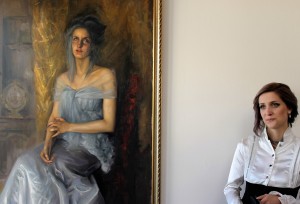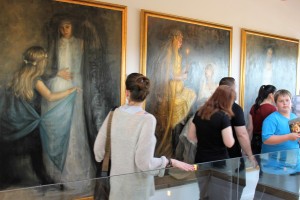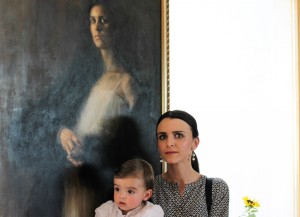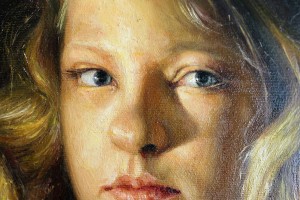A graduate of the Nis School of Arts, Milica Kostic opened her first solo exhibition on May 28 in Hotel Gracanica, just outside of Prishtina.
Not far from Prishtina at Hotel Gracanica,where green fields surround the white, minimalist, and very modern building, the first solo exhibition of the young Kosovo artist Milica Kostic is taking place.
Although her paintings are realist, one can also find some Manga influences and elements in the hairstyles of the painter’s subjects. In most cases, the garb is classical, but in the faces one can notice contemporary features.
Kostic’s powerful subjects reflect her own feelings at the moment she is painting an art piece. “That’s how I experienced it, that’s how I see it, and there I go, I put it on canvas,” explains Kostic.
She is only 24. Born in 1991 in Prishtina, Kostic now lives in the suburbs of Kosovo’s capital, the village Laplje Selo. She finished her bachelor and master studies in Nis University of Arts in Serbia this year.

Milica Kostic standing next to her “Self Portrait.”
Kostic decided to title her first solo exhibition “Parallel Worlds.” The title might resonate with the parallel lives Serbs and Albanians lead in Kosovo, although the author is unwilling to provide that explanation. She does however admit that her own life in the village parallels how life in general works nowadays.
“I love Kosovo, our history, the land where I was born, the province in which I was born, but I don’t know what to say… Sometimes I feel like I don’t belong to this era,” she says smiling, as we talk next to one of her many portraits that stand as contemporary homages to 19th century painting. “But, when I’m here [in Laplje Selo] I somehow get detached from all of these issues.”
Lapjle Selo is a bucolic village in the municipality of Gracanica, one of the largest Serb municipalities in Kosovo. Being only a few kilometers from the capital, the area has become a trade hub for Serbs and Albanians alike, while Hotel Gracanica also attracts international patronage.
Kostic is critical of topics that most people are interested nowadays.
“Everyone is interested in this Third World War that is happening – maybe not a physical war, but it’s happening through media, internet… It affects human psychology, and I’m not sure if people understand that,” says Kostic, worryingly.
“I think that the most important war is the one with ourselves,” she adds.
When asked about her everyday life in Kosovo Kostic seems a bit confused. She would love to be treated normally in the city she was born, to be part of the artistic life of her birthplace, but she is not. Indeed, no artists from the capital’s usual art scene are attending her opening – in fact not even a single ethnic Albanian (with the exception of this author) is in attendance.

“I know that among our people [Albanian and Serb] there are differences but I would love to… my paintings say this: faith, love, and hope. I think there is hope that everything will be better,” says Kostic, doubtfully looking at her nails. “But yes, I would love to feel free to go every day in Prishtina, in the Art Gallery and to socialize with people there.” She does not have to add that she cannot.
This exhibition was taking place in a village, in a hotel and not where it should have happened, in any art gallery in Prishtina. Since the Kosovo war ended in 1999, most Kosovo Serbs live in municipalities with a Serb majority which do not recognize Kosovo’s independence. Very little cooperation exists between young Albanians and Serbs, who have official representatives in the Kosovo parliament and government.
Unlike northern Mitrovica, which is physically separated by the river Iber, Gracanica is next to Prishtina and serves as a hub for trade and other commercial activities. Unlike businessmen and politicians, artists such as Kostic who have few opportunities to exchanges and cooperation with their Albanian peers.
An connoisseur of painting can see the influences of titans such as Caravaggio (when it comes to the darkness that surrounds the subjects); Velasquez when it comes to their powerful positions, and Rembrandt when it comes to a vividly clear focus on the details, leaving the rest of the painting opaque.
Kostic confirms these influences from the masters and adds a list of her own contemporary favorites such as Alyssa Monks and Jeremy Lipking, who like her are influenced by realist figurative painting.
A self-portrait, 170×100 cm, portrays the painter in tears holding brushes in both hands. In the painting she seems dissatisfied, or rather devastated, desperate to make others understand her suffering.
Kostic says she’s not painting the motives of what she calls “The World War Three” but the small individual feelings that cause it: “Pride”, “Greed”, “Jealousy”, “Anger” are names of the paintings that stand opposite to “Faith”, “Hope” and “Love”.

Kostic’s sister and subject standing underneath the painting “Greed.”
Serbian Orthodox theology seems to have shaped her through years, but for Kostic the three theological virtues of Christianity come in a different way. There is no St. Sophia with her three daughters, there are no virgin ladies nor naked babies to represent the virtues in Kostic’s painting. Instead, there is a pregnant young woman telling a secret to a girl that might be her sister, and that represents “Faith.”
Another shows an angel holding a candle who is telling the bride (a self-portrait of Kostic) the good news – representing “Hope”. And in another extraordinary depiction, a little girl kneeling in front of her grandmother while looking to the audience, which Kostic says represents pure love.
One of her models, present at the exhibition, is her sister. She has been posing for a beautiful painting of a woman wearing a furry black coat with a hard gaze at the spectators.
“You’ve seen my sister, and look at this,” Kostic points me towards the painting. The difference is stark – Kostic’s sister looks meek in contrast. “The topic is greed,” the painter adds, indicating the detail of the ring the woman is wearing.
The real-life model, in contrast, is a shy modest mother holding her baby while a photographer takes pictures of them.
“I modify my models. I give them my feelings, my idea on the characters and that’s how I create them. Some people come to me and say my characters don’t belong the 21st century. I think that’s my signature,” she says smiling.
Kostic’s maxim is not a contemporary one. She harkens back to ancient philosophy, to the ancient Temple of Apollo at Delphi. “Know thyself” – was the forecourt of the temple and one of the maxims Socrates used in his dialogues. Kostic has adopted this as her maxim as well.
“In order for the bad to be stopped we need to know ourselves,” she says.






